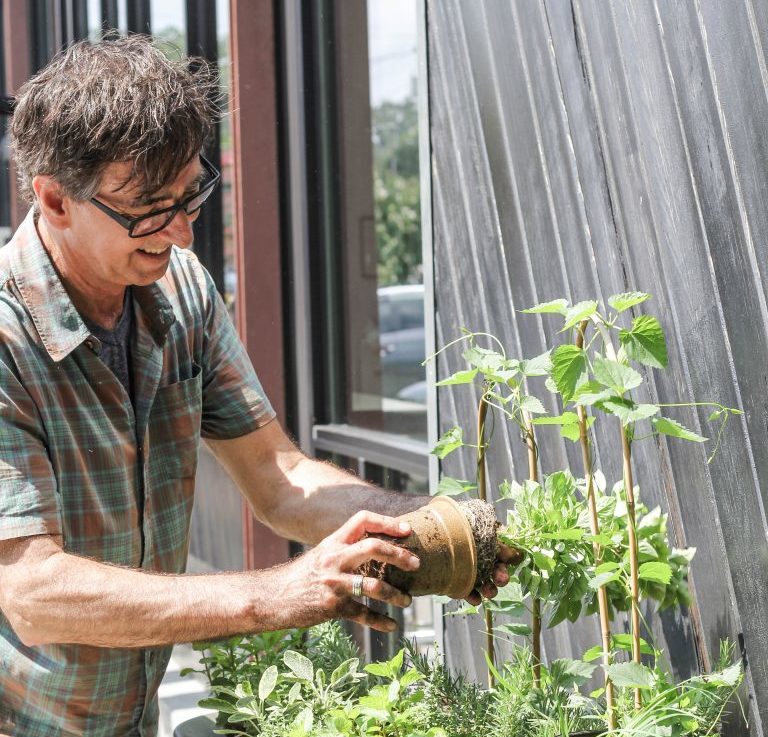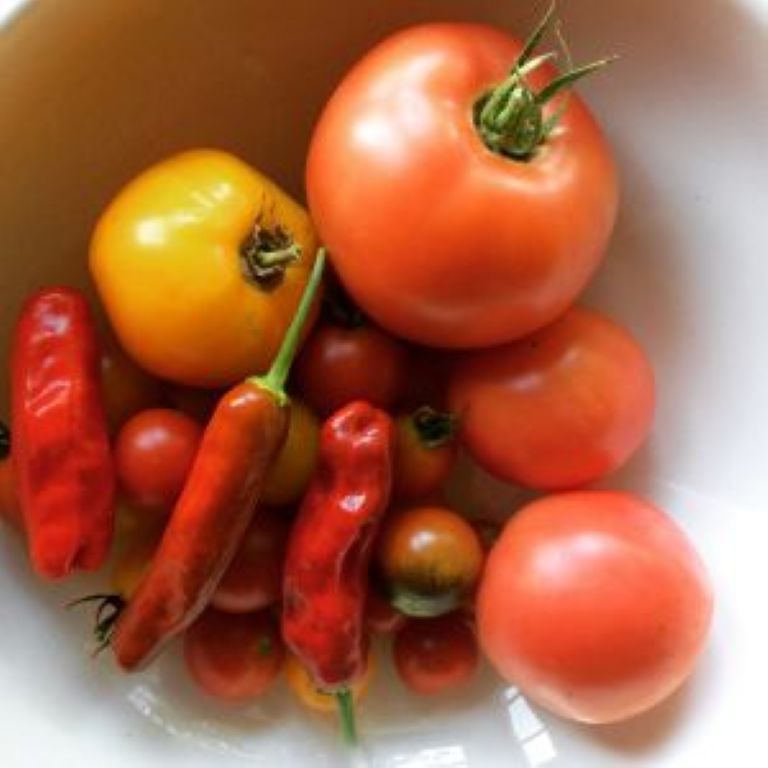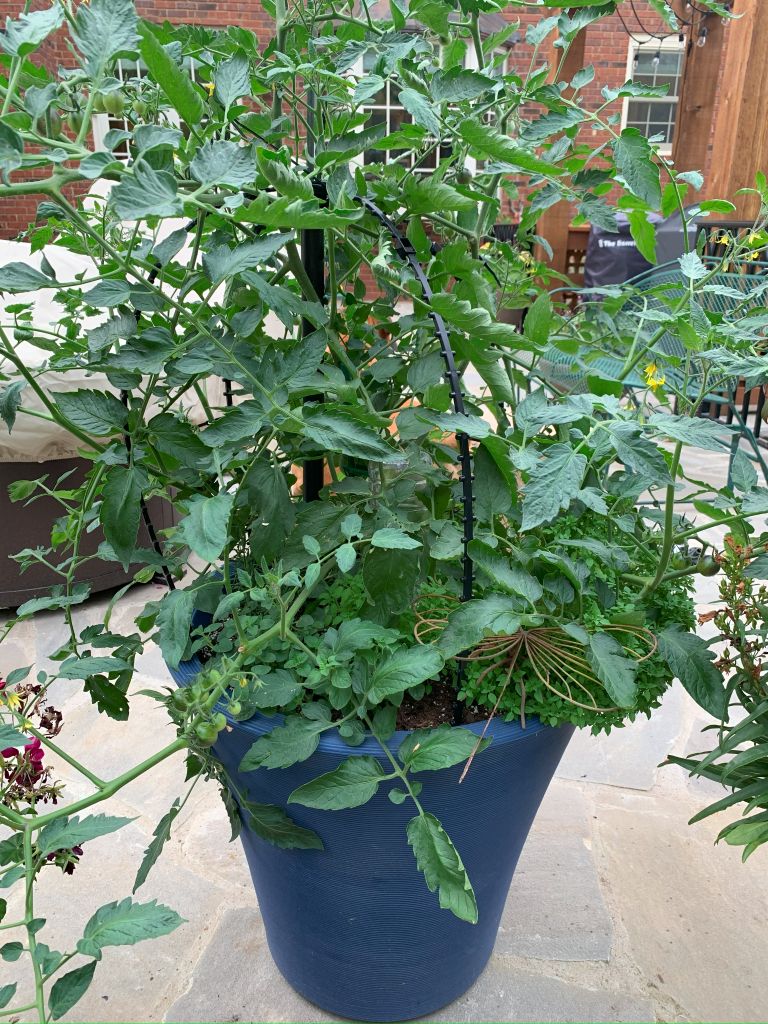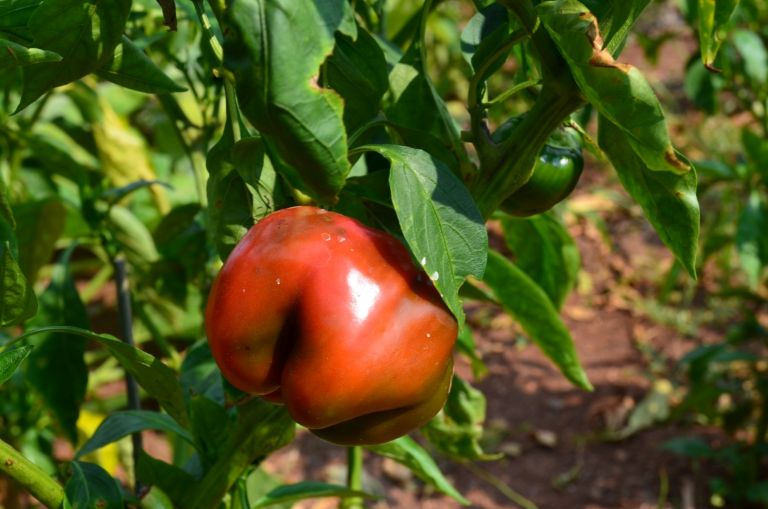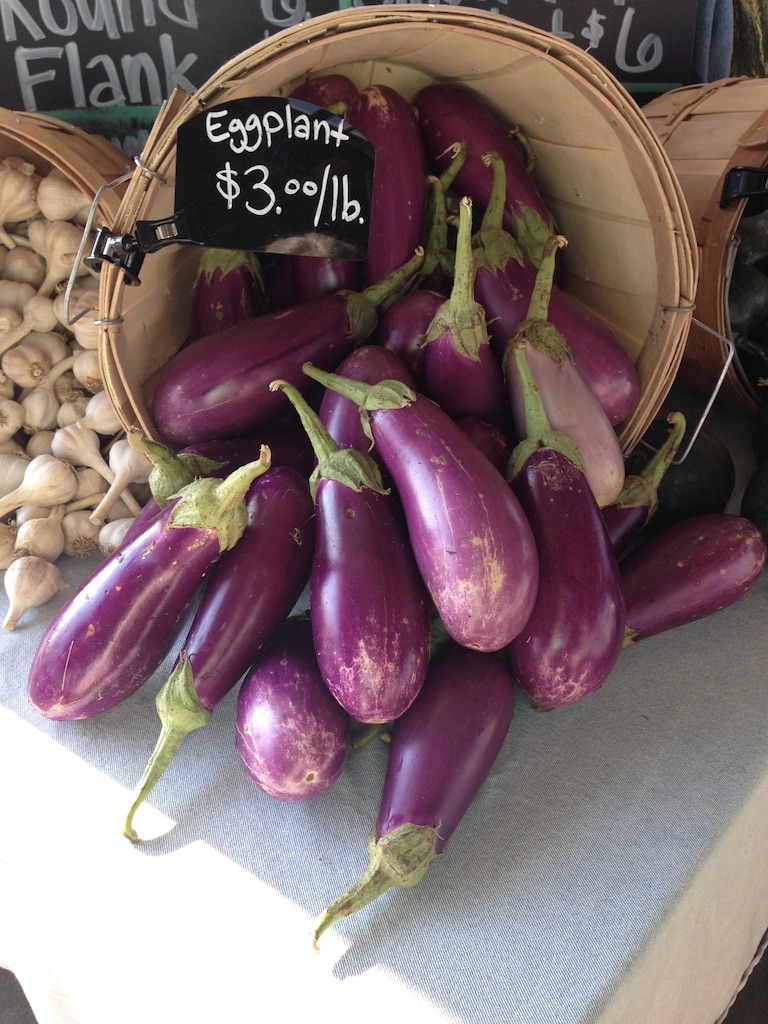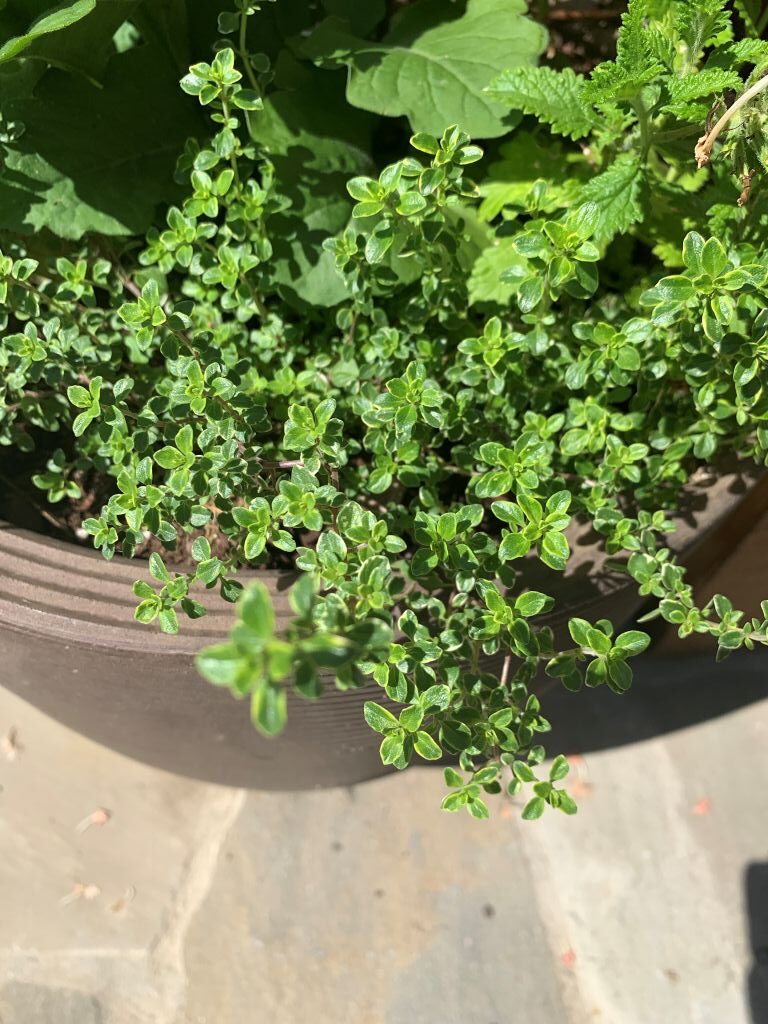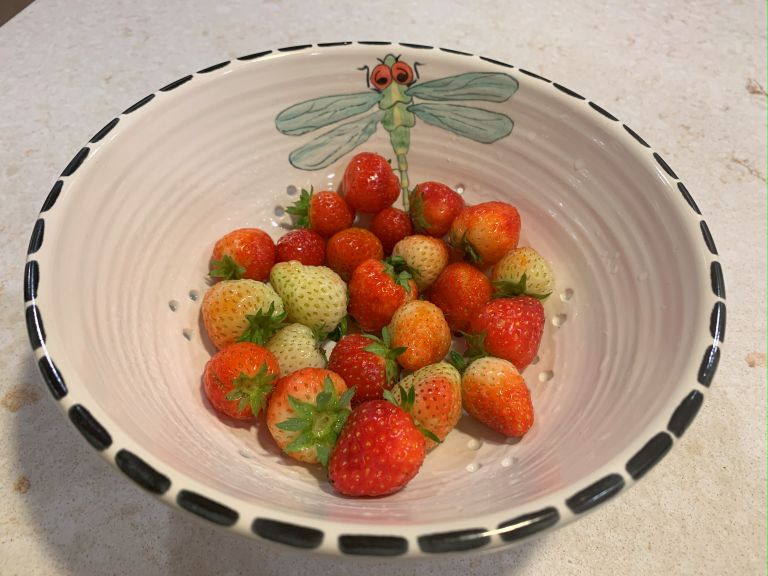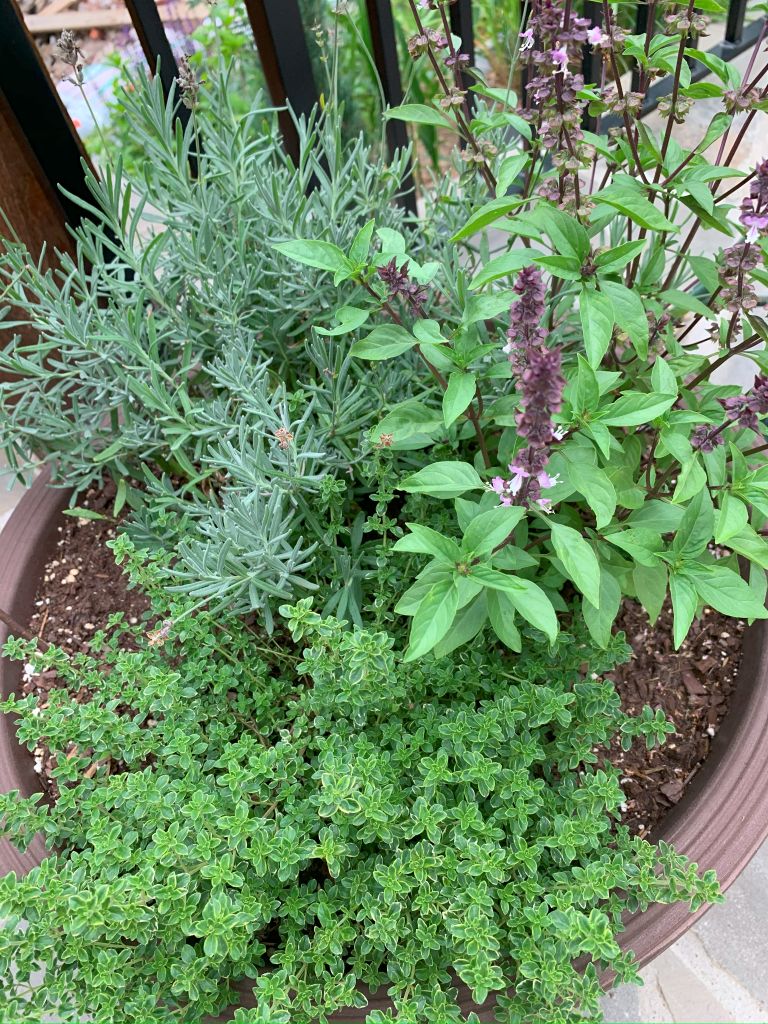Is Mastering the Art of French Cooking your go-to cookbook, or are you an instinctive chef that creates delicious dishes on the fly? Do you aspire to compete on “Top Chef,” or are you constantly looking for inspiration when you open the refrigerator? Whether you’re a gourmet cook or simply struggle to get dinner on the table before racing off to a ball game or yoga class, you’ll boost your meal-planning inspiration when you grow your own food! Creating gorgeous containers filled with plants you can eat not only makes a beautiful addition to your backyard, patio, or balcony, it also inspires your meals with fresh, seasonal produce.
From lush, ripe heirloom tomatoes in a rainbow of colors to fragrant, pretty herbs that add flavor and interest to recipes, growing edibles make mealtime easier. Head out to your container garden to see what’s ripe and ready to harvest. Use your homegrown goodies as the basis of your meal planning. If you want to create homemade pasta sauce or whip up a refreshing drink, we’ve put together great edible plant combinations to grow in containers that will add homegrown goodness to your plate!
Growing food in containers is simple. Choose a large container, add potting soil, place in a sunny location near a water source, and create a beautiful, edible container garden that will inspire your kitchen adventures! Check often for pests or water needs, and don’t forget to feed your green babies. Pick one container garden combination, or plant them all for long seasons filled with homegrown goodness!
Perfect Pasta Sauce
Do you love preserving the taste of summer to enjoy all winter long? If you do, dust off your nana’s secret tomato sauce recipe, because now you can grow your own ingredients! The crops in this container make scrumptious Caprese salad or bruschetta, too—perfect for a light summer meal or appetizer.
Plants You’ll Need:
- 1 tomato plant, dwarf or bush preferred
- 5 sweet basil plants, like ‘Genovese’
- 2 oregano plants
How to Plant:
Place the tomato plant in the back center of the container and plant deeply. (It will develop more roots along the stem for extra stability.) If you chose an indeterminate tomato plant, add a support—it will grow tall, making a great vertical addition to the container! Add oregano plants on the left and right edges of the container as a “spiller.” Place the basil plants in the center of the container as “fillers.” If you like, add a few flowers, like marigolds, for a pop of color between the basil. Water well to settle the plants.
Salsa Pot
Elevate your Taco Tuesday game with homegrown salsa! What’s your heat tolerance: mild, a bit of a kick, or hotter than Hades? You can create your favorite sweet or scorchingly spicy salsa when you grow your own ingredients. If you prefer milder salsa, try Jalapeno or Poblano peppers. For a bit of heat, grow Habanero or Scotch Bonnet peppers. Or, if you’re one of those salsa connoisseurs who prefer eye-tearing, taste-bud-numbing heat, add Ghost or Carolina Reaper peppers to your container combination!
Plants You’ll Need:
- 1 hot pepper plant
- 1 tomato plant, bush or dwarf preferred
- 4 cilantro plants (if you dislike cilantro, substitute parsley or basil plants)
- 3 chive plants
How to Plant:
Place the tomato plant in the rear of the pot and the pepper near the front, so that there’s plenty of room for these larger plants to grow. (Add a support for the tomato plant if you’ve chosen an indeterminate variety.) Plant the cilantro along the edge of the pot, allowing it to spill over the edge as it grows. Tuck the chives between the pepper and cilantro—the lavender flowers will add a pretty burst of color to the container, and the herb adds a garlicky-onion flavor to the salsa. Water well. Feed the plants throughout the growing season with a water-soluble fertilizer for edible plants, as both tomatoes and peppers are heavy feeders and need extra nutrients.
Homegrown Ratatouille
If you’re dreaming of travel and miss the taste of Provence, try growing your own ingredients to create homemade ratatouille. For this container recipe, we recommend a grouping of three containers, as the ingredients require different water needs, plus one zucchini plant can fill a container:
Container A—Plants You’ll Need:
- 1 tomato plant, bush or dwarf preferred
- 1 eggplant
- 4 basil plants
How to Plant:
Plant the tomato in the back of the container, adding support if growing an indeterminate variety. Plant the eggplant toward the front of the container. Tuck the basil plants between the tomato and eggplant, along the rim of the container. Water well, and fertilize according to directions on the label.
Container B—Plants You’ll Need:
- 1 zucchini plant, compact or bush variety
- 4 nasturtium plants (optional)
How to Plant:
Plant the zucchini in the center of the container and water well. If you like, add trailing nasturtium flowers, which are edible, along the edge of the container to attract pollinators. (Use the flowers to garnish the ratatouille after baking.)
Container C—Plants You’ll Need:
- 8 onion transplants or sets
- 10 garlic cloves
- 3 thyme plants
How to Plant:
Place the garlic cloves in the center of the container, spaced 2 inches apart, pointed side up. Plant the onions to surround the garlic in a circle spaced 3 inches apart. Add the thyme plants along the edge of the container to spill over the side. Water well. Onions can be harvested while young and green, if you like, or wait for the bulb to mature. When the garlic scapes appear, snap them off and use in your favorite recipe, but allow the bulb to continue to grow. (Removing the scapes, or the flower shoot, redirects the plant’s energy into forming a larger bulb.)
Strawberry Lemonade Pot
Whether you enjoy an evening cocktail or prefer a refreshing mocktail after a busy day, growing your own ingredients makes for a sweet, rewarding way to unwind! If you live in a warm climate, lemon trees can grow outside all year long. But if you live in USDA zones 8b and above, move your lemon tree inside for protection during cold months.
Plants You’ll Need:
- 1 lemon tree
- 7 everbearing strawberry plants
- 3 borage plants (optional)
How to Plant:
Place the lemon tree in the center of the container. Space the borage plants to surround the lemon tree, if you like. Add the strawberry plants along the outer circle of the container to spill over the edge. Water well, and feed throughout the season. Edible borage flowers make a pretty garnish for drinks, or add the blooms to an ice cube tray, fill with water, and freeze to create beautiful blooming ice cubes!
Herbes de Provence Pot
If Julia Child is your hero, add a collection of herbs to up your culinary game! This Mediterranean-based herb blend traditionally features dried rosemary, lavender, oregano, marjoram, and thyme (and sometimes summer savory and basil). The plants in this container recipe prefer drier growing conditions than many vegetables and herbs, so they work well together in one pot. Make sure the container drains well, as these herbs dislike wet feet.
Plants You’ll Need:
- 1 large rosemary plant
- 2 lavender plants
- 2 oregano plants
- 2 sweet marjoram plants
- 2 thyme plants
How to Plant:
Place the large rosemary in the center of the container. Add one lavender plant on either side of the rosemary—but slightly in front of it. Add the oregano, sweet marjoram, and thyme plants along the edge of the container, alternating the plants to mix textures. Water well, then let the container to dry out between waterings.
Salad and Stir-Fry Pot
Summer isn’t the only season to grow delicious ingredients in containers. Plant cool-season crops in fall and spring. Chard, kale, lettuce, and parsley actually prefer cool temperatures and taste better before summer’s heat arrives. An added bonus: this container garden grows well in partial sun.
Ingredients:
- 3 Swiss Chard plants
- 2 curly kale plants
- 5 lettuce plants
- 3 curled parsley plants
- 5 viola plants (optional)
How to Plant:
Place the three Swiss chard plants in the center of the container in a “triangle” (two plants slightly back and one forward.) Add the curly kale on either side of the chard. Evenly space the 5 lettuce plants to surround the kale and Swiss chard. Place the parsley and viola plants, alternating, along the edge of the container Water well. The outer leaves of the lettuce, kale, parsley, and Swiss chard can be continuously harvested, allowing the plants to grow all season. Violas add a pretty pop of color to salads—plus, they’re edible!
Other Edibles for Container Growing
Some plants need to be grown alone in containers, but they add amazing flavor to your favorite recipes. Mint, for instance, will overtake other plants—it’s quite the garden bully! However, it’s a versatile herb, creating delicious drinks–from festive mojitos to the traditional Kentucky Derby mint juleps to a soothing tea—sweetly spicing couscous or salads, or adding a tasty flavor to desserts. (Really, is there anything more delicious than mint paired with chocolate?)
Growing ginger in containers offers the perfect solution for gardeners living in colder climates. While ginger can grow in-ground in USDA zones 7b and warmer, it’s easy to add rhizomes—the roots of the ginger plant—to containers. Ginger grows beautifully outside during warm months, but planting it in a container provides the flexibility to move it inside when chilly temperatures arrive. It’s easy to grow, too. Look for an organic ginger root at the grocery store with buds on it–they look similar to the “eyes” on potatoes. Plant thumb-sized pieces of the rhizome in spring, 1 inch deep in potting soil, with the buds facing up. (One piece will eventually fill a 2-gallon container.) Place the container in full sun, with a bit of afternoon shade if you live in the south. The plant will start to emerge in a few weeks. Water regularly and deeply. When temperatures fall to 50 degrees Fahrenheit, move the container inside. As ginger grows, add more soil over the rhizome, called “hilling,” because light will turn the root green. Ginger can grow 4 to 5 feet tall and is ready to harvest 8 to 10 months after planting. (When the leaves turn yellow, it’s time to harvest.) You can also snap off a piece of the rhizome to use in cooking, repotting the plant so it can continue to grow.
Pick your favorite foods, select a container, and get growing! You’ll love creating a beautiful, edible container garden—but most of all, enjoy cooking your favorite recipes using homegrown food!
